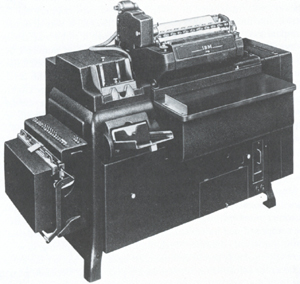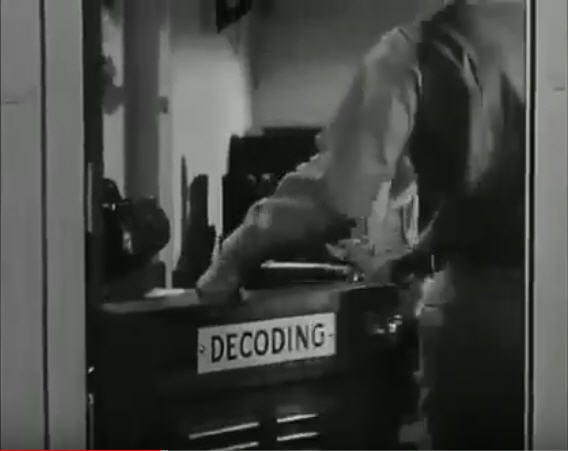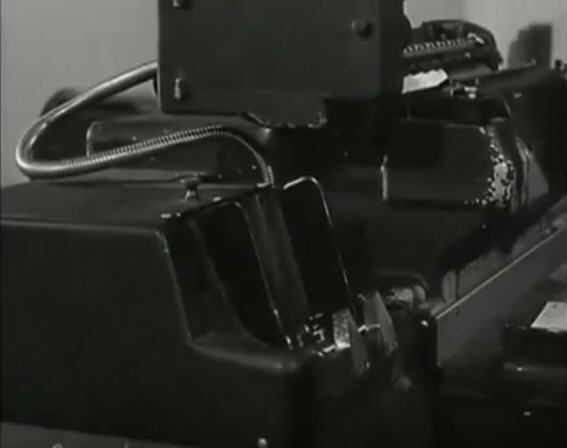
|
| The IBM 405 Alphabetical Accounting Machine.
Photo:
from Grosch [57] 1st Ed.
|
The IBM 405 Alphabetical Accounting Machine, 1934. This was IBM's high-end
tabulator offering (and the first one to be called an Accounting Machine),
complementing its numeric-only
285. The 405 was
programmed by a removeable
plugboard with over
1600 functionally significant "hubs", with access to up to 16 accumulators,
the machine could tabulate at a rate of 150 cards per minute, or tabulate
and print at 80 cpm. The print unit contained 88 type bars, the leftmost 43
for alphanumeric characters and the other 45 for digits only. The 405 was
IBM's flagship product until after World War II (in which the 405 was used
not only as a tabulator but also as the I/O device for top-secret relay
calculators built by IBM for the US Army Signal Corps in 1943, used for
decrypting German and Japanese coded
messages [
40]). In 1952, IBM first
used
core memory in an experimental 405
model [
4].

|
| Another view of the 405 from
[4];
CLICK to enlarge.
|
Herb Grosch recalls of his early days at
Columbia University's
Watson Lab [
57]:
"About equipment: after merging in the better machines from the
[
Astronomical Computing Bureau in the]
Pupin attic (I
kept the old
285 horizontal tabulator
as long as Marjorie [Severy] had room for it, out
of sheer wonder at its clumsiness), we had two machine rooms with sorters and
reproducers and collators, an interpreter, a gang punch, and several key
punches. The most expensive machine (renting for over $1000 a month with all
the bells and whistles I could hang on it) was the huge 405 tabulator, with 80
characters of alphanumeric storage, eating and disgorging 150 80-character
cards a minute, printing 80 characters wide a line at a time (the type bars
were too long to do this at full speed, but
other models could print numbers
only, at 150 lines a minute or 200 digits a second; the earth shook!)."
Also see
Commentary
I received the following email from "Strontium Black Cat"
a.k.a. "Henry" in November 2018:
On your "The IBM 405 Alphabetical Accounting Machine" web page under the
"Also see:" header it is stated that:
- "The film Infinity (Matthew Broderick, 1996), a story of the Los Alamos
years of Richard Feynman, for a brief look at a 405 in action (the machine
in the film might be a 402, which was not introduced until 1948)."

|
| Click to enlarge
|
I found the film on YouTube (with an overbearing Russian audio translation
on top - but hey - it's the image that we are most interested in)
"infinity бесконечность 1996 {En Rus алаб}"
https://www.youtube.com/watch?v=upqbgWDZQzI.
Starting at the following movie time stamps:
01:02:27 IBM 403 (appears NOT to be the IBM 402 as suggested above - see clip)
01:02:44 IBM 75? (card sorter)
01:03:08 IBM 26? (card punch which 026.html states was introduced
in July 1949! )
01:03:38 (shows bits of IBM equipment in foreground and background)
01:03:53 (shows a lot more of the IBM 75? in the background)
01:20:24 IBM 26? (card punch)
-
I found Wing and Prayer on YouTube:
"Uma Asa e uma Prece 1944 Leg Dana Andrews Don Ameche"
https://www.youtube.com/watch?v=-vfrTcbCEx4 -
IBM 405 in operation - time stamp 01:08:02 - 01:08:19
(Me again, Frank) Following up on
this... THIS
LINK (for as long as it lasts) takes you directly to the sequence of
interest in Wing and a Prayer, and I took some screenshots:

|
| Receiving the message
|

|
| Taking it to the decoding room
|

|
| Punching the message onto cards
|

|
| The IBM 032 card punch
|

|
| The IBM 405
|

|
| Putting the cards into the 405 hopper
|

|
| IBM 405 type bars in action
|

|
| Printed page comes out
|

|
| Printing complete
|
Clearly neither the 032 nor the 405 could decrypt the message, so how does
it come out of the 405 in clear text? What is not shown in the film is that
the 405 is merely the i/o device for an
unseen top-secret IBM relay
calculator that decrypts the message.











